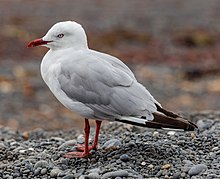| Red-billed gull | |
|---|---|

| |
| Adult | |
| Scientific classification | |
| Domain: | Eukaryota |
| Kingdom: | Animalia |
| Phylum: | Chordata |
| Class: | Aves |
| Order: | Charadriiformes |
| Family: | Laridae |
| Genus: | Chroicocephalus |
| Species: | |
| Subspecies: | C. n. scopulinus
|
| Trinomial name | |
| Chroicocephalus novaehollandiae scopulinus | |
| Synonyms | |
|
Larus novaehollandiae scopulinus, Larus scopulinus | |
The red-billed gull (Chroicocephalus novaehollandiae scopulinus), also known as tarāpunga and once also known as the mackerel gull, is a native seagull of New Zealand, being found throughout the country and on outlying islands including the Chatham Islands and subantarctic islands. It was formerly considered a separate species but is now usually treated as a subspecies of the silver gull (Chroicocephalus novaehollandiae).[2][3]
The Māori name of this species is tarāpunga or akiaki.[4] Its vernacular name is sometimes also used for the dolphin gull, a somewhat similar-looking but unrelated species that is found in coastal southern Chile, Argentina and the Falkland Islands.[5] As is the case with many gulls, the red-billed gull has traditionally been placed in the genus Larus.
A national survey of breeding red-billed gulls carried out in 2014–2016 recorded 27,831 pairs nesting in New Zealand. The authors of the study based on the survey and published in 2018 said that the accuracy of previous estimates was questionable, but that the species nevertheless appeared to have declined nationally since the mid-1960s. The study also discussed the possible reasons for the decline and made a proposal for future monitoring.[6]
- ^ "Larus novaehollandiae scopulinus". nztcs.org.nz. Retrieved 2022-09-14.
- ^ Gill, Frank; Donsker, David, eds. (2019). "Noddies, gulls, terns, auks". World Bird List Version 9.2. International Ornithologists' Union. Retrieved 24 June 2019.
- ^ Burger, J.; Gochfeld, M.; Kirwan, G.M.; Garcia, E.F.J. "Silver Gull (Larus novaehollandiae)". In del Hoyo, J.; Elliott, A.; Sargatal, J.; Christie, D.A.; de Juana, E. (eds.). Handbook of the Birds of the World Alive. Lynx Edicions. doi:10.2173/bow.silgul2.01. S2CID 241433727. Retrieved 21 April 2017.
- ^ Barrie Heather & Hugh Robertson (2005). The Field Guide to the Birds of New Zealand (revised ed.). Viking.
- ^ "Dolphin Gull (Larus scoresbii) - BirdLife species factsheet". datazone.birdlife.org. Retrieved 2019-03-22.
- ^ Taylor, Graeme A.; Frost, Peter G.H. (2018). "The status of the red-billed gull (Larus novaehollandiae scopulinus) in New Zealand, 2014–2016" (PDF). Notornis. 65. Birds New Zealand: 1–13. Archived from the original (PDF) on 2019-02-01. Retrieved 2019-03-22.
Cite error: There are <ref group=lower-alpha> tags or {{efn}} templates on this page, but the references will not show without a {{reflist|group=lower-alpha}} template or {{notelist}} template (see the help page).
